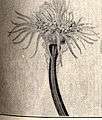Augusta Foote Arnold
Augusta Newton Foote Arnold (October 24, 1844 – May 9, 1904) was an American author who published three books, two cookery books under the nom de plume Mary Ronald, and The Sea-Beach at Ebb-Tide, regarded as a seminal work on the intertidal biology of the United States.
Augusta Foote Arnold | |
|---|---|
| Born | Augusta Newton Foote October 24, 1844 Seneca Falls, New York, U.S. |
| Died | May 9, 1904 (aged 59) Manhattan, New York, U.S. |
| Spouse(s) | Francis Benjamin Arnold
( m. 1869; |
| Children | 3 |
| Parent(s) | Eunice Newton Elisha Foote |
| Relatives | Mary Foote Henderson (sister) Samuel A. Foot (uncle) |
Personal life
Augusta was born in Seneca Falls, New York on October 24, 1844. Her father was Elisha Foote, a judge, inventor, Commissioner of the US Patent Office and mathematician, and her mother was Eunice (née Newton) Foote, a scientist and first female scientist carrying out experiments in her own laboratory. Eunice Newton Foote described and explained the "Green House Gas Effect" in 1856 or 3 years before Irishman John Tyndall who is widely credited with that research. Mother Eunice Newton Foote was also women's rights campaigner and signatory to the Declaration of Sentiments. Both Mary and Augusta carried on their parents legacy of science.[1] Her older sister was the artist and writer Mary Foote Henderson, who married U.S. Senator John B. Henderson who was the co-author of the Thirteenth Amendment to the United States Constitution which abolished slavery.[1]
She was educated at private schools in Saratoga Springs, New York.[2]
Career
Augusta wrote three books. The first was The Century Cook Book, which was published under the pseudonym Mary Ronald in 1895, and the third was also a cook book published under that pseudonym, Luncheons, A Cook's Picture Book; A Supplement to the Century Cook Book in 1905.[2]
Arnold's second book was her only work of scientific writing: The Sea-Beach at Ebb-Tide, A Guide to the Study of the Seaweeds and the Lower Animal Life Found Between Tidemarks, a guide to the flora and invertebrate fauna of the inter-tidal zones of the coasts of the United States, mainly the eastern coast. This book was promoted in the United States' most popular children's magazine of that era, the St. Nicholas Magazine, and it may have had an influence on a generation of American naturalists, including Rachel Carson and Ed Ricketts; the book is cited in the bibliographies of works by these naturalists. John Steinbeck was also known to have been a reader of the magazine. Other American marine biologists, such as Myrtle E. Johnson, Richard Knapp Allen, and Joel Hedgpeth, mention or comment on The Sea Beach at Ebb-Tide.[3]
Arnold was a member of the Torrey Botanical Club and of the American Association for the Advancement of Science, indicating that she considered herself to be a serious scientist.[3]
Eponyms
Although the identity of the person honored in the specific name of the Pacific leaping blenny (Alticus arnoldorum), is unclear, Anthony Curtiss who described that species is known to have read The Sea-Beach at Ebb-Tide and gave several other taxa a similar epithet, which is thought to be in commemoration of Arnold.[4]
Personal life
On March 6, 1869, she was married to Francis Benjamin Arnold in Washington D.C..[5] Francis was the son of Benjamin Green Arnold (founding president of the Coffee Exchange in the 1880s) and Frances (née Snow) Arnold,[6] and the brother of Charlotte Bruce Arnold.[7][8] The Arnolds were neighbors of sculptor Augustus Saint-Gaudens in Cornish, New Hampshire, who made a bust of her father-in-law between 1877 and 1880.[9] The couple had three children, two sons and a daughter:[2]
- Benjamin Foote Arnold (1870–1896)[2]
- Henry Newton Arnold (1873–1939), who married Sophia Blum (1885–1950) and served as Assistant Attorney General under George W. Wickersham in the Taft Administration.[10]
- Frances A. Arnold (1874–1975)[7]
She died, age 59, on May 9, 1904 at her residence, 101 West 78th Street in New York City.[11] After a funeral at All Souls' Church, she was buried Woodlawn Cemetery in Bronx, New York.[12]
Gallery
A sample of some of the plates from The Sea-Beach at Ebb-Tide:
 Frontispiece
Frontispiece Hybocodon prolifer
Hybocodon prolifer_and_egg-cases.jpeg) Fulgur canalliculava whelk and egg cases
Fulgur canalliculava whelk and egg cases
 Polysiphonia dendroidea, a piece magnified
Polysiphonia dendroidea, a piece magnified
References
- Elizabeth Wagner Reed (1992). "Eunice Newton Foote". American women in science before the civil war. Archived from the original on 6 October 2016. Retrieved 24 February 2019.
- "Augusta Foote Arnold family papers 1893-1903". New York Public Library. Retrieved 24 February 2019.
- Robert Jan 'Roy' van de Hoek (May 2008). "Augusta Foote Arnold". Ballona Institute. Retrieved 24 February 2019.
- Christopher Scharpf; Kenneth J. Lazara (26 October 2018). "Order BLENNIIFORMES: Family BLENNIIDAE". The ETYFish Project Fish Name Etymology Database. Christopher Scharpf and Kenneth J. Lazara. Retrieved 24 February 2019.
- Burke, Arthur Meredyth (1991). The Prominent Families of the United States of America. Genealogical Publishing Com. p. 404. ISBN 9780806313085. Retrieved 13 June 2019.
- Browning, Charles Henry (1883). Americans of Royal Descent. Porter & Costes. p. 139. Retrieved 13 June 2019.
- Early American Silver in The Metropolitan Museum of Art. Metropolitan Museum of Art. 2013. p. 191. ISBN 9781588394910. Retrieved 13 June 2019.
- "Teapot,ca. 1782 Paul Revere Jr. American". www.metmuseum.org. The Metropolitan Museum of Art. Retrieved 13 June 2019.
- Dryfhout, John H. (2008). The Work of Augustus Saint-Gaudens. UPNE. p. 89.
- "HENRY N. ARNOLD, ONCE LAWYER HERE; Assistant Attorney General in Taft Administration Dies in Washington BLACK TOM CASE COUNSEL Rough Rider With Roosevelt in Cuba--Major During the World War" (PDF). The New York Times. 8 June 1939. Retrieved 13 June 2019.
- "DIED. ARNOLD". The New York Times. 10 May 1904. Retrieved 13 June 2019.
- "DIED. ARNOLD" (PDF). The New York Times. 11 May 1904. Retrieved 13 June 2019.
External links
| Wikisource has original text related to this article: |